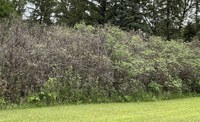Dakota Gardener: Too much of a good thing
(Click an image below to view a high-resolution image that can be downloaded)
By Joe Zeleznik, Forester
NDSU Extension
My friends in western North Dakota are breathing a sigh of relief this year.
After several years of drought, some timely rains are happening, and in decent amounts. Well, mostly timely, and mostly in decent amounts. There are still some droughty spots out there.
Nevertheless, conditions have improved substantially across a large region. There’s more forage production for livestock and crop yields should be good. The trees are doing better, too.
On the eastern and central side of the state, it’s a different story. Total rainfall for the year is slightly above average, and there have been some real soakers over the past few months. That can cause some problems.
One of the biggest issues we’re seeing this year is foliar fungal problems. Ash anthracnose was more common this spring, apple scab and frogeye leaf spot are hitting the ornamental crabapples, and oak trees have problems like oak leaf blister and their own anthracnose disease.
Lilacs are taking it extra hard. There’s a fungal problem called Pseudocercospora that’s defoliated large numbers of these shrubs in this region and into Minnesota. This is the second year in a row that the conditions are perfect for this disease, and the lilacs are hurting.
Individual shrubs in my neighborhood are nearly defoliated, with only a few leaves left to produce energy through photosynthesis. Some shelterbelts are suffering as well.
Last year, infected lilacs went dormant a bit early, and many of them had a second flush of flowers in September. Even my own lilacs did that. They were pretty, but I was worried that using that extra energy would cause dieback over the winter.
Fortunately, my lilacs flushed out their leaves this past spring like they always do, and they were ready for another year.
But Nature had different plans for our trees and shrubs.
Most trees and shrubs can take one year of defoliation. If they were otherwise healthy going into the stress, they’re likely to weather it – no pun intended – just fine.
But two years of defoliation is a bit stressful on any perennial. And a third year is even worse.
How do we deal with foliar diseases?
First, good sanitation is critical. Rake up and destroy dead leaves this fall. That helps to reduce the fungal load for next year.
Second, preventative fungicides can be applied in the spring, as the leaves are beginning to expand. While fungicides can help prevent new infections, they won’t cure trees that are already infected. Additional fungicide treatments might be needed further into the spring and summer, depending on the weather.
People often think that adding fertilizer can help a tree recover. Getting proper nutrition will help the tree mount its best defenses, right?
It’s complicated.
The science on this is really mixed. Nutrients usually help a tree rebuild green tissue – leaves – but nutrients won’t give trees the energy they need to grow those leaves. And sometimes, greener leaves can be great food for insect pests. Fertilizers are best applied in the spring and early summer.
Too much of a good thing – water, fertilizer, sunlight – can be tough on trees. The right balance, with the right timing, is the best for the trees in the long run.
Sounds like good advice for people, too.
NDSU Agriculture Communication – Aug. 20, 2025
Source: Joe Zeleznik, 701-231-8143, joseph.zeleznik@ndsu.edu
Editor: Kelli Anderson, 701-231-6136, kelli.c.anderson@ndsu.edu




